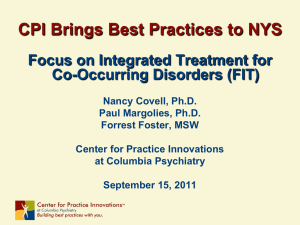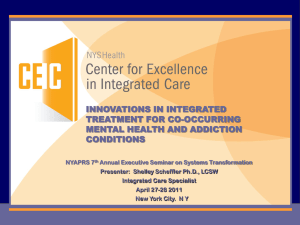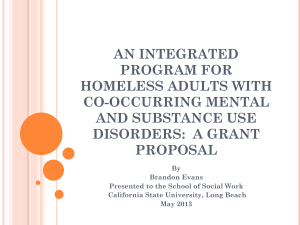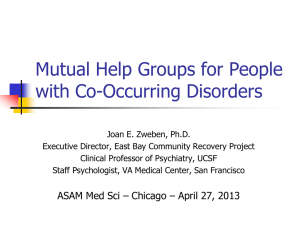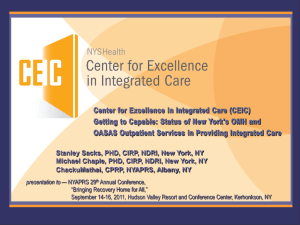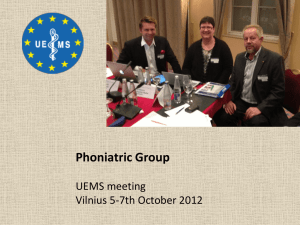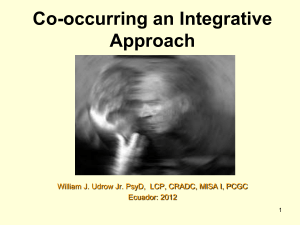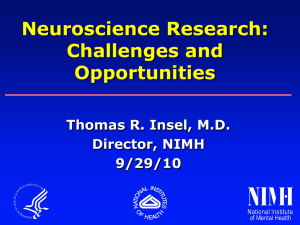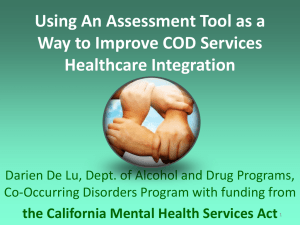Presentation - Case Western Reserve University
advertisement
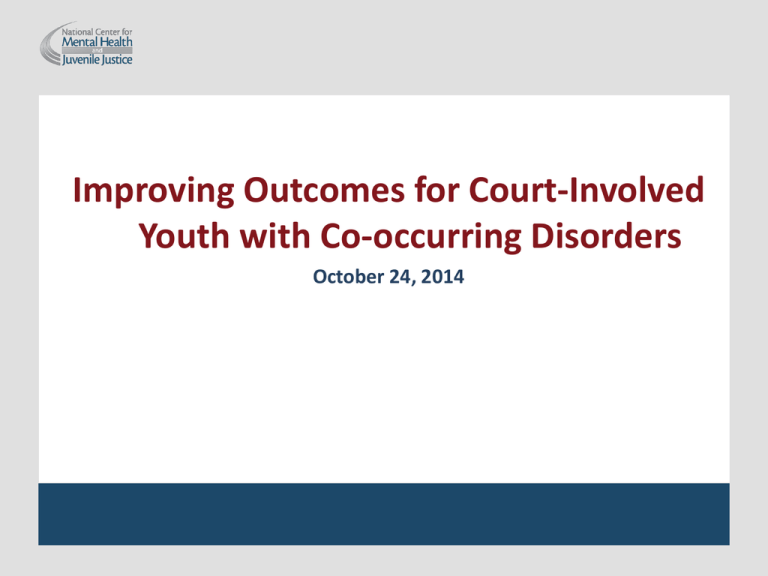
Improving Outcomes for Court-Involved Youth with Co-occurring Disorders October 24, 2014 Moderator: Joseph J. Cocozza, Ph.D. Director, National Center for Mental Health and Juvenile Justice Coordinator: Tom Templeton, M.S.Ed. Project Assistant II, National Center for Mental Health and Juvenile Justice FYI… The recording of this webinar, along with the PowerPoint slides, will be available at ncmhjj.com If you experience technical issues during the webinar, please use the chat feature to ask for help The format of today’s webinar will include three presentations A follow-up Ask the Expert series will be held to allow sufficient time for questions and discussion An eBlast with registration information for the Ask the Expert sessions is forthcoming to all webinar participants Ask the Experts Schedule Wednesday, November 12, 2014 2:00 PM EDT – 3:30 PM EDT Robert Kinscherff, Ph.D., J.D. Friday, December 5, 2014 2:00 PM EDT – 3:30 PM EDT Holly Hills, Ph.D. Wednesday, December 17, 2014 2:00 PM EDT – 3:30 PM EDT Richard Shepler, Ph.D., PCC-S Improving Outcomes for Court-Involved Youth with Co-occurring Disorders October 24, 2014 Sponsored by the National Center for Mental Health and Juvenile Justice and the National Council of Juvenile and Family Court Judges Objectives This webinar is designed to identify the need for addressing court-involved youth with co-occurring disorders suggest new directions for improving policies and programs describe effective treatment models that address the needs of youth with co-occurring disorders offer examples of model programs that have demonstrated success Why Focus on Youth with Co-occurring Disorders? Many youth involved in the juvenile justice system simultaneously experience both mental health and substance use disorders, also known as co-occurring disorders Research shows that these youth present multiple, complex issues, and demonstrate poor treatment outcomes Their presence creates unique challenges for juvenile drug treatment courts Changes in policy, practice, and treatment are necessary to successfully address the needs of youth with co-occurring disorders Advancing Juvenile Drug Treatment Courts (Briefs available at ncmhjj.com) Developing Effective Policies for Addressing the Needs of Court-Involved Youth with Co-occurring Disorders Robert Kinscherff, Ph.D., J.D. and Joseph J. Cocozza, Ph.D. Providing Effective Treatment for Youth with Co-occurring Disorders Patrick Kanary, E.Ed., Richard Shepler, Ph.D., PCC-S, and Michael Fox, M.A., PCC New Directions to Address Co-occurring Mental Disorders Holly Hills, Ph.D., and Karli J. Keator, M.P.H. Presenters Robert Kinscherff, Ph.D., J.D. Senior Associate at the National Center for Mental Health and Juvenile Justice; Associate Vice President for Community Engagement at the Massachusetts School of Professional Psychology Richard Shepler, Ph.D., PCC-S Senior Research Associate at the Begun Center for Violence Prevention Research and Education, the Jack, Joseph, and Morton Mandel School of Applied Sciences, Case Western Reserve University Holly Hills, Ph.D. Associate Professor in the Department of Mental Health Law and Policy at the Louis de la Parte Florida Mental Health Institute in the College of Behavioral and Community Sciences at the University of South Florida Developing Effective Policies for Addressing the Needs of Youth with Co-occurring Disorders Robert Kinscherff, Ph.D., J.D. Increasing Awareness of COD Recognition that policy and program changes are needed to address courtinvolved youth with co-occurring mental and substance use disorders Develop the local capacity for integrated care to effectively treat these youth Key Decisions in Building COD Capacity Establishing Eligibility and Exclusion Criteria Screening and Assessment Youth and Family Involvement Integrated Treatment Services Violations, Sanctions, and Rewards Graduation Expectations Adapting Policy for Youth with COD Eligibility Criteria Criteria broadly excluding youth with MHD should be changed to permit inclusion of youth with MHD Avoid using criteria exclusively based upon specific diagnosis and focus instead upon degree of functional impairment arising from the MHD and the SUD Adapting Policy for Youth with COD Screening and Assessment Screening of all potentially eligible youth for both MHD and SUD using consistent protocols and empirically validated tools for screening Refer youth screened “positive” for individualized assessments: • Administered by clinicians trained in COD assessment methods • Attentive to trauma-informed assessment • Geared toward case-specific plans, “treatment “matching” • Focused upon effective, integrated treatment Adapting Policy for Youth with COD Youth and Family Involvement Better outcomes with higher level of family engagement Consider requiring family participation in screening, assessment, and treatment by at least one “family” member (not necessarily a parent) Family-Friendly practices including • Scheduling when working parents can attend • Assisting with transportation, child care • Being sensitive to cultural issues • Recognizing family members who support recovery • Recruiting parents with “lived experience” as supports • Inviting parents with “lived experience” as JDC team members • Inviting former youth participants (graduates) as JDC team members Adapting Policy for Youth with COD Integrated Treatment Services Better outcomes with integrated EBP treatment Avoid settling for what is available if inadequate “Something is better than nothing” = FALSE Work with community-based clinical services providers to develop capacity for evidence-based integrated COD treatment • • • • Bring insurers and other funders into the conversation Consider incentivizing a provider with sole referrals Access technical support and consultation Avoid “parallel” or “serial” treatment approaches Adapting Policy for Youth with COD Violations, Sanctions and Rewards Just as SUD recovery is characterized by relapse along the way to recovery, MHD may have a waxing and waning course of symptoms despite participation in treatment (especially in early phases of treatment). Violations and sanctions should focus on treatment engagement, not solely fluctuations of symptoms Violations, sanctions, rewards should consider: • Treatment attendance and participation • Degree of progress in SUD recovery • Indications of functioning at home, school, community Adapting Policy for Youth with COD Graduation Expectations Ordinarily hold youth with COD to same criteria as those with just MHD or SUD Consider whether failure to achieve some expectations (e.g., school attendance) reflects functional impact of active mental disorder beyond the ready control of the youth Focus upon ultimate markers of success in COD which include • Active participation in integrated treatment • Evidence of SUD recovery over time • Improved functional capacities, reduce impairment • Reduced re-arrest and violations of JDC expectations Adapting Policy for Youth with COD Emerging Models for Court-Involved Youth with COD Are promising but still developing Require key modifications in JDC policies Should provide access to integrated COD treatment Providing Effective Treatment for Youth with Co-occurring Disorders Richard Shepler, Ph.D.,PCC-S 3 Types of Treatment for Co-Occurring Disorders Sequential: traditional belief that symptoms of one disorder (SU/MH) can’t be resolved until the symptoms of the other disorder are addressed Parallel: both services provided at same time by different professionals in different systems or agencies, with different treatment plans Integrated: mental health and substance use treatment is provided by one provider with one assessment and one treatment plan Youth with co-occurring disorders are best served through an integrated screening, assessment, and treatment planning process that addresses both mental and substance use disorders, each in the context of the other Treatment of Youth with Co-occurring Disorders: What We Have Learned • Look for treatment programs that offer both substance use and mental health approaches delivered in home and community environments: • • • • • Integrated Co-Occurring Treatment (ICT); Family Integrated Transitions (FIT), Multidimensional Family Therapy (MDFT), Functional Family Therapy-CMT (FFT-CMT), Multisystemic Therapy-SU (MST-SU). • Optimal effects require interventions that impact youth symptom patterns (behaviors, cognitions, emotions), trauma, risk and safety issues, family systems and recovery environments, peer relationships, school and community functioning, and positive development. Influence, Interaction, and Manifestation of Multiple Occurring Conditions Contexts (Home, School, Peers, Community, etc.) Substance Use Disorder Mental Health Disorder Family Trauma Factors Youth Risk & Resiliency Factors Developmental Factors Safety Concerns Salient Behavior/ Symptom Integrated Co-Occurring Treatment Integrated Co-Occurring Treatment (ICT) is a promising practice that utilizes an integrated treatment approach, embedded in an intensive home-based service delivery model, to provide both mental health and substance abuse treatment services to youth with co-occurring disorders of substance use and serious emotional disability and their families. Services are provided in the home, school and community where the youth lives, with the goal of safely maintaining the youth in the least restrictive, most normative environment. Main Purpose: Placement prevention Reunification Stabilization and safety ICT Core Assumptions 1. Youth with COD present with multiple and complex symptom patterns and behaviors, which adversely affect their functioning in developmentally important life domains. 2. COD presentation in youth is affected by brain development; and conversely, brain development is impacted by substance use. 3. Traumatic stress experiences contribute to impaired emotional and behavioral functioning and to the adoption of risk behaviors, which in turn may lead to further exposure to victimization, violence, and trauma experiences. 4. Safety concerns and risk behaviors are elevated and need to be intensively managed and monitored. ICT Core Assumptions (cont.) 5. Contextual factors (peers, family, school, neighborhood, and the risk and protective factors associated with them) play a mediating role in youth behaviors, use patterns, and recovery trajectory. 6. The stressors associated with co-occurring disorders negatively strain family emotional, interpersonal, and material resources. 7. Treatment engagement and readiness to change are more difficult to attain and sustain. Intensive Home-Based Service Delivery Modality Cross-System Collaboration and Service Coordination Multidimensional and Integrated Assessment and Conceptualization Comprehensive and Integrated Treatment Array Matched to Needs and Strengths Resiliency-Oriented Developmental Perspective Culturally Mindful Engagement and Family Partnerships ICT Model Components ICT Core Services • • • • • • • Crisis intervention and stabilization Individually-focused cognitive, emotional, and behavioral treatments Skill building and psycho-education Motivational interviewing Family-focused, systemic interventions Cross-system coordination and supports Asset and support building activities (e.g. linkage to recovery mentor) Target Outcomes Increase functioning in major life contexts so that the youth is: • Living at home or in a permanent home setting • Attending and achieving at school/work • Reduced involvement in the JJ system • Reduced use/no use of substances • Participating in positive family, peer, and community life • Improved family recovery environment • Accessing resources and natural supports as needed to maintain gains and prevent recidivism Realistic Outcomes and Expectations • Think trajectory of wellness not cure • Youth living with mental health and substance use disorders often have ongoing treatment and/or support needs • Substance use is a chronic relapsing disorder (Dennis) Completion rates low High rate of treatment drop-out Relapse common • Measure what you do: risk reduction across life domains Track multiple outcomes • Conversation with key stakeholders about realistic outcome expectations (increased functioning; decreased level of care needs; etc.) New Directions to Effectively Address Co-occurring Mental Disorders Holly Hills, Ph.D. Program Modifications to Address Co-Occurring Disorders • Evaluate the available service continuum and build relationships to fill needs • Consider altering program policies and criteria • Modify the content of screening and assessment tools Examples of Program Modifications • Summit County, OH: Crossroads Program • Ouachita Parish, LA: 4th Judicial District Juvenile Drug Treatment Court Summit County, OH: Crossroads Program • 70 youth annually, aged 12-17, post adjudication • Can get records expunged if they successfully complete • 4 phases of contact, from weekly to monthly meetings, over a year’s time Summit County, OH: Crossroads Program • Youth receive services in their home • 3-5 hours of contact with their counselor per week • Probation Officers are trained in Motivational Interviewing and Cognitive Behavioral Therapy • POs meet with youth under their supervision 2-3x per week Summit County, OH: Crossroads Program • Sanctions: electronic monitoring, suspension of driver’s license, changes in curfew • Incentives: Field trips, movie / sports tickets, gift cards Ouachita Parish, LA: 4th Judicial District • Youth, age 10-17 get a clinical eligibility screening to determine program course • Youth with CODs participate for approximately 9 months • Utilize structured screening and assessment measures Ouachita Parish, LA: 4th Judicial District • 2 contacts with Case Manager weekly • 2 contacts with Probation Officer weekly • Evolving to 2x month over program term Ouachita Parish, LA: 4th Judicial District • Two Program “Tracks” • Track 2 has four phases with an additional aftercare phase Ouachita Parish, LA: 4th Judicial District Juvenile Drug Treatment Court Program Elements • Cannabis Youth Treatment (CYT) and Solution Focused Brief Therapy (SFBT) • Collaboration between the Court and the University of Louisiana, Monroe • Family member / Guardian must complete a ‘Family Action Plan’ Ouachita Parish, LA: 4th Judicial District Juvenile Drug Treatment Court Program Elements • Incentives = gift cards, sports tickets, decreased time spent in a Phase • Sanctions = writing assignments, increased frequency in court • Graduation requires 8 weeks with no positive drug screens, and compliance with interventions Conclusion • Recognition of significant numbers of youth with CODs may require • Modification of mission • Review / expansion of Screening and Assessment Measures • Adoption of Evidence-based Practices • Expanding Access to Psychopharmacology • Review of Outcome Measures Reminder… The recording of this webinar, along with the PowerPoint slides, will be available at ncmhjj.com A follow-up Ask the Expert series will be held to allow sufficient time for questions and discussion An eBlast with registration information for the Ask the Expert sessions is forthcoming to all webinar participants Ask the Experts Schedule Wednesday, November 12, 2014 2:00 PM EDT – 3:30 PM EDT Robert Kinscherff, Ph.D., J.D. Friday, December 5, 2014 2:00 PM EDT – 3:30 PM EDT Holly Hills, Ph.D. Wednesday, December 17, 2014 2:00 PM EDT – 3:30 PM EDT Richard Shepler, Ph.D., PCC-S Contacts Robert Kinscherff: rkinscherff@prainc.com Richard Shepler: Richard.Shepler@case.edu Holly Hills: hhills.tpa@gmail.com Tom Templeton: ttempleton@prainc.com
